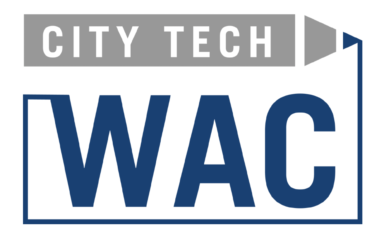A central tenet of the Writing Across the Curriculum (WAC) pedagogy is that the act of writing is in itself a process of learning. The clearest example of this to me is the exploratory writing assignment, where students are asked to write in a way that is relatively brief, informal, and low-stakes, to help develop and clarify their ideas rather than to present a formal written product. In this blog post, I explore the rationale for using exploratory writing to facilitate student learning, discuss strategies for designing effective writing assignments, and share some of my own experiences incorporating writing (imperfectly) into a 150-student, largely lecture-based undergraduate abnormal psychology course.

Writing to Change Thinking
Exploratory writing is meant to be a work in progress – freeform, sometimes stream of consciousness writing that is used to stimulate and refine ideas, rather than a completely polished report with a clearly delineated thesis and carefully deliberated evidence. Exploratory writing assignments are thus ideal for when students have not yet fully formed their thoughts on a topic, as it encourages them to translate their partially constructed ideas into words. This process, this struggle of putting ideas into coherent sentences pushes students to provide structure and narrative to their thoughts, since the words they write should still be coherent to a reader, even if imperfect in grammar or syntax. Translating thoughts to text can in turn inspire ideas, realizations, or even questions that then spark more ideas. When we ask students to engage in exploratory writing then, we are asking them to begin developing, organizing, and restructuring their thoughts, and to invite us into their minds as they play out this process on the page.
Although the notion that writing can be used to change ideas is not new, there is compelling evidence to support this phenomenon, particularly through clinical trials of writing as a form of therapy for people with posttraumatic stress disorder (PTSD). PTSD is a mental health condition which can develop after someone experiences a traumatic event, and one core feature of PTSD is having negative thoughts about oneself (e.g. “I’m a failure,” “I’m to blame for what happened”), others (e.g. “people are untrustworthy,” “everyone wants to hurt me”), or the world at large (e.g. “the world is dangerous,” “the world is unfair”). Though there are several ways of treating PTSD, gold standard treatments such as cognitive-behavioral therapy and cognitive processing therapy typically include strategies to change these negative thoughts, as they can contribute to the maintenance of other PTSD symptoms. In other words, a primary goal in the treatment of PTSD is to help people relearn the way that they think.
Expressive writing, or freewriting about thoughts and emotions related to the traumatic experience, has consistently been shown to improve PTSD symptoms. In his seminal study on expressive writing, psychologist James Pennebaker (1986) had two randomly assigned groups of participants complete 15-minute freewrites on 4 consecutive days. The expressive writing group was asked to describe their feelings about a personal traumatic experience, while a control group was asked to objectively describe a neutral topic (such as their living room or their clothing). Interestingly, after a 6-month follow-up, participants in the experimental writing condition were less likely to have sought medical care than people in the control condition, demonstrating that a brief writing exercise could lead to changes in health outcomes even months later. This finding sparked an interest in writing as a means of therapy, and over the next three decades, hundreds of studies have largely supported the finding that expressive writing can improve PTSD symptoms (and potentially other mental health conditions such as depression), albeit at a small to medium magnitude (Reinhold et al. 2017). Although the exact mechanism for how writing improves PTSD symptoms requires more study, evidence for the cognitive model of PTSD suggests that expressive writing allows people to make meaning of their traumatic experience, constructing narratives that make sense of the trauma in ways that change the negative cognitions they have about themselves, others, and the world (Sloan and Marx, 2004).
The literature on expressive writing and PTSD provides evidence of how exploratory writing can be an effective means of helping people change the way they think, by helping them make sense of their thoughts and ideas. In the context of undergraduate education, exploratory writing can similarly be used to foster critical thinking skills. By asking students to write about the ideas, theories, and information we present them with in class, we challenge them to grapple with and make sense of the topics we teach, possibly changing the way they understand the world as they consider a different way of thinking. Although it can seem daunting to include more writing into our courses, exploratory writing assignments can actually facilitate engagement with the coursework and help us achieve the learning objectives of our courses. As Bean and Melzer (2021) describe, instructor testimony has consistently reported that the “payoff of exploratory writing is students’ enhanced preparation for class, richer class discussions, and better product writing” (p. 117).

Maximizing Student Buy-in
Given all the benefits of exploratory writing, how do we actually incorporate it into our courses? A key component of developing effective exploratory writing assignments is to facilitate student buy-in. If the writing assignments begin to feel like busy work, students will be less inclined to put effort into the assignments, if they do them at all. So how might we maximize the likelihood that students are invested in the writing assignments? There are three strategies that I think can be particularly effective.
First, we should emphasize to students that these assignments are low-stakes, largely graded on completion (if graded at all) and are designed to help develop ideas. This means that students should write to get their ideas on the page, without paying inordinate attention to grammar, punctuation, or syntax. Hopefully, this lets students understand that the assignments are not meant to waste their time, but simply to help them better engage with the course material.
Second, exploratory writing assignments should be integrated into the course design, such that it builds upon other aspects of class. For instance, an in-class writing assignment at the beginning of class might be used to facilitate classroom discussions or groupwork, or a writing assignment might be used to brainstorm and develop ideas for a formal paper or an exam question. Ideally, students should be able to see how these assignments have a function within the larger structure of the course, rather than being standalone assignments that need to be completed for the sake of completion (i.e. busy work).
And lastly, writing assignments should feel relevant to the lives of our students in some way. Students are more likely to complain about an assignment when they do not see the purpose of it, and I think that an important factor in encouraging students to see that purpose is by designing our assignments to help students apply the information they are learning to their own lives (more on that later). Ultimately, we create these assignments because we want our students to be interested in the topics we teach, so the best way of fostering engagement is by using them to show our students why our topics of interest are so interesting in the first place!

Strategies for Exploratory Writing Assignments
Now, what might exploratory writing assignments actually look like? Exploratory writing can take many forms, including “journals, notebooks, thinking pieces, marginal notes in books, nonstop freewrites, reading logs, diaries, daybooks, letters to colleagues, electronic postings, notes dashed off on napkins, [and] early drafts of essays” (Bean and Melzer, 2021, p. 94), all of which can be incorporated into class time or assigned as homework. However, the format the writing assignment takes may be less important than how the prompts are structured. Since the purpose of the writing should be to encourage thinking, asking students to regurgitate information from a textbook (e.g. to define a term or explain a theory they read about in a chapter) may not be the best way of using exploratory writing. Rather, asking students to find and reiterate information encourages cursory reading, and similar to the control condition of Pennebaker’s experiment, likely has limited impact on the processing and reworking of information that is so crucial to critical thinking.
A more effective way of fostering engagement with readings may be to ask students how they could apply the information they are learning to other contexts. In my abnormal psychology course, I have often found that students are most engaged when they are able to see how the topics we cover are relevant to their own experience. For example, when we discuss specific phobia, I ask students to write about their own anxieties and fears, and then try to draft an exposure hierarchy for themselves (which they could use if they were doing exposure therapy for their fear). Applying the exposure hierarchy to their own lives can help students better understand how exposure therapy can reduce anxiety. This exploratory writing assignment also provides me with the opportunity to gauge students’ understanding of material, since I can quickly go through responses and provide individual feedback to students who are completing the hierarchy inaccurately.
Similarly, students can be asked to apply information from the course to current events or intellectual debates. Although current events may not be immediately relevant to every discipline, every discipline has unanswered questions that can be fruitful for classroom discussion. As an example, gender dysphoria is a disorder that is currently debated in the medical literature, as there are proponents and critics of keeping it as a medical diagnosis. In my lectures on gender dysphoria, I try to present students with arguments for both sides, and then give them an exploratory assignment where I ask them to choose a side and explain why. This type of assignment can help students clarify their thinking on the topic, and I believe also demonstrates to students how real-world problems don’t necessarily have a “right” answer, because professionals in the discipline also need to struggle with ambiguous and imperfect solutions.
Another way of asking students to apply information to other contexts is by asking them to assume a different role in their response. For instance, after lectures about historical perspectives on mental illness, I present students with a case study and ask them to write out a diagnosis and treatment plan for a patient, first as a discipline of Hippocrates in ancient Greece and then again as a modern cognitive-behavioral psychologist in private practice. Similarly, students can be asked to take on a “teacher” role by asking them to teach a topic to someone outside of the discipline (e.g. “Explain this theory to your grandmother”), or perhaps a role specific to the discipline (e.g. “Imagine you are on the hospital ethics committee and you were reviewing this case, what might your concerns be?”). Prompting students to take on a different role in their writing assignments encourages them to see a problem from another perspective, to use their imagination and try to understand why the information we present can be important in various contexts. Encouraging this use of perspective is not only applicable across disciplines, but can also be fun for students to write, and fun for us to read!
Exploratory writing assignments can also be used to help students explore the process of learning itself, by having students write about their experience engaging with course material. For example, an in-class writing assignment at the beginning of class might be to ask students to “describe the most confusing part of the readings for today,” which can then facilitate a class discussion on the difficulties of the assigned reading. In my own course, I offered students an extra credit opportunity to provide weekly feedback about the class, where students who completed at least 6 weekly feedback forms would receive a few points extra credit on their exam scores. The forms were identical every week, and primarily asked students to share what they liked most from the week, what they liked least, and what they were still unsure about or confused by. I found that these forms often helped me get a sense of which topics students were most confused about, and therefore which topics I may need to teach differently or emphasize less of on our exams. Another benefit was that in my end-of-course evaluations, many students have commented on how they appreciated being able to provide feedback about the course, and felt that their concerns were heard even within such a large class.
Another way to explore the process of learning can be to demonstrate to students how their own ideas have changed and developed. One way of doing so may be to use exploratory writing assignments as an iterative process. For instance, if students are required to submit a formal project, exploratory writing assignments could be used as a means of scaffolding, such as by having students brainstorm ideas, submit an initial draft, provide notes for their peers, and then revise and resubmit. An additional writing assignment might be to have students write about their own development, between their initial brainstorming to their final product. Although I haven’t been able to implement this type of scaffolding in my own course just yet, I have asked students to write about their opinions on a topic (e.g. substance use) and then to revisit their opinions after reading an article or watching an informational video. I have found that these assignments, asking students to write about how their own ideas have changed, are often the ones that students report to be the most memorable at the end of the semester.
Although I unfortunately have not had the opportunity to teach since learning about WAC pedagogy, I have found in my previous experience that exploratory writing assignments can be very effective in promoting student engagement with course content and enriching classroom discussions, even within a large, primarily lecture-based course. Engaging in WAC pedagogy has deepened my appreciation for the utility of writing to facilitate student learning across all disciplines, and I look forward to further integrating writing assignments into my courses for when I teach next.
References
Bean, J. C., & Melzer, D. (2021). Engaging ideas: The professor’s guide to integrating writing, critical thinking, and active learning in the classroom. John Wiley & Sons.
Pennebaker, J. W., & Beall, S. K. (1986). Confronting a traumatic event: Toward an understanding of inhibition and disease. Journal of Abnormal Psychology, 95(3), 274–281.
Reinhold, M., Bürkner, P. C., & Holling, H. (2018). Effects of expressive writing on depressive symptoms—A meta‐analysis. Clinical Psychology: Science and Practice, 25(1), e12224.
Sloan, D. M., & Marx, B. P. (2004). Taking pen to hand: evaluating theories underlying the written disclosure paradigm. Clinical psychology: Science and practice, 11(2), 121.








